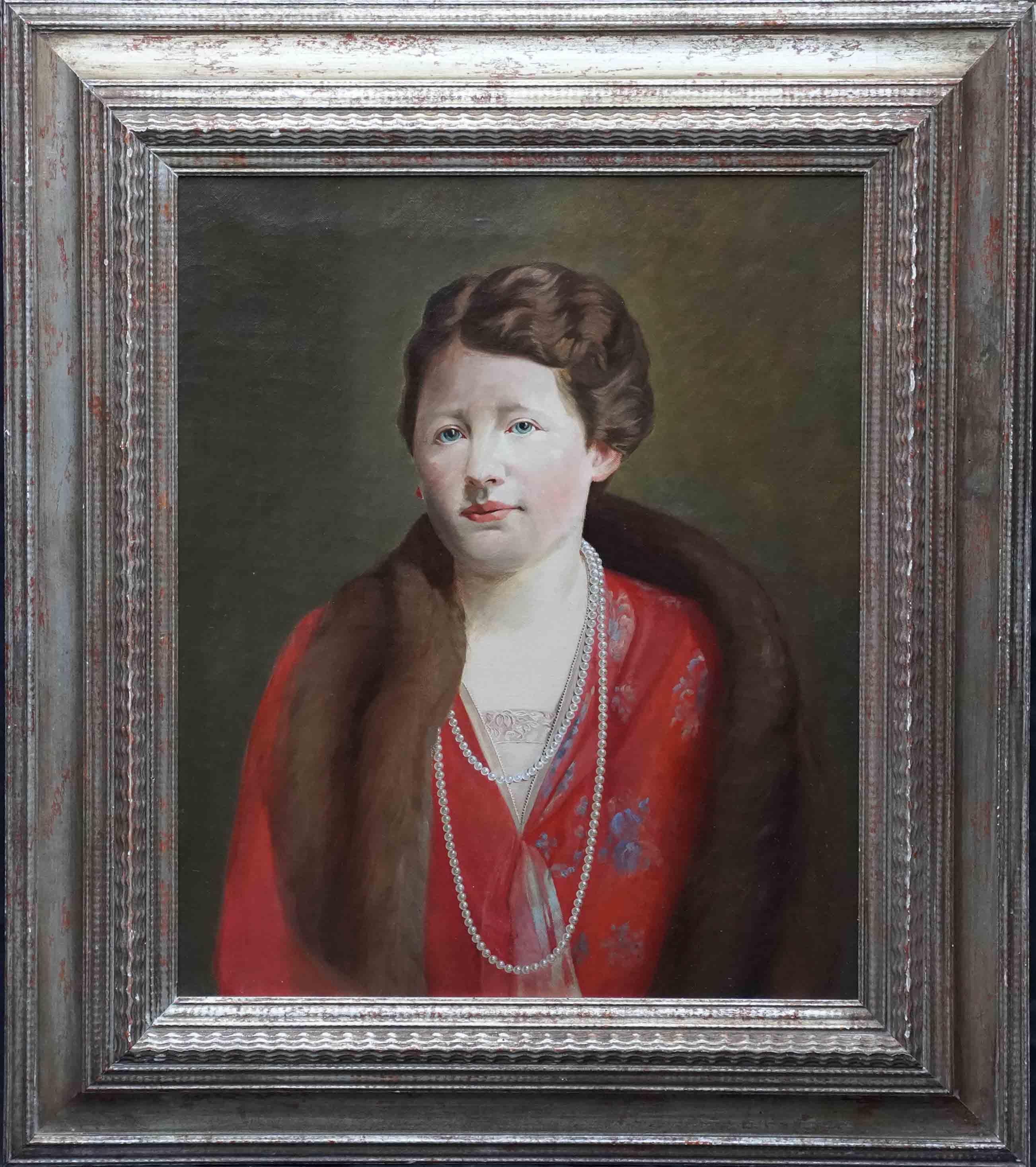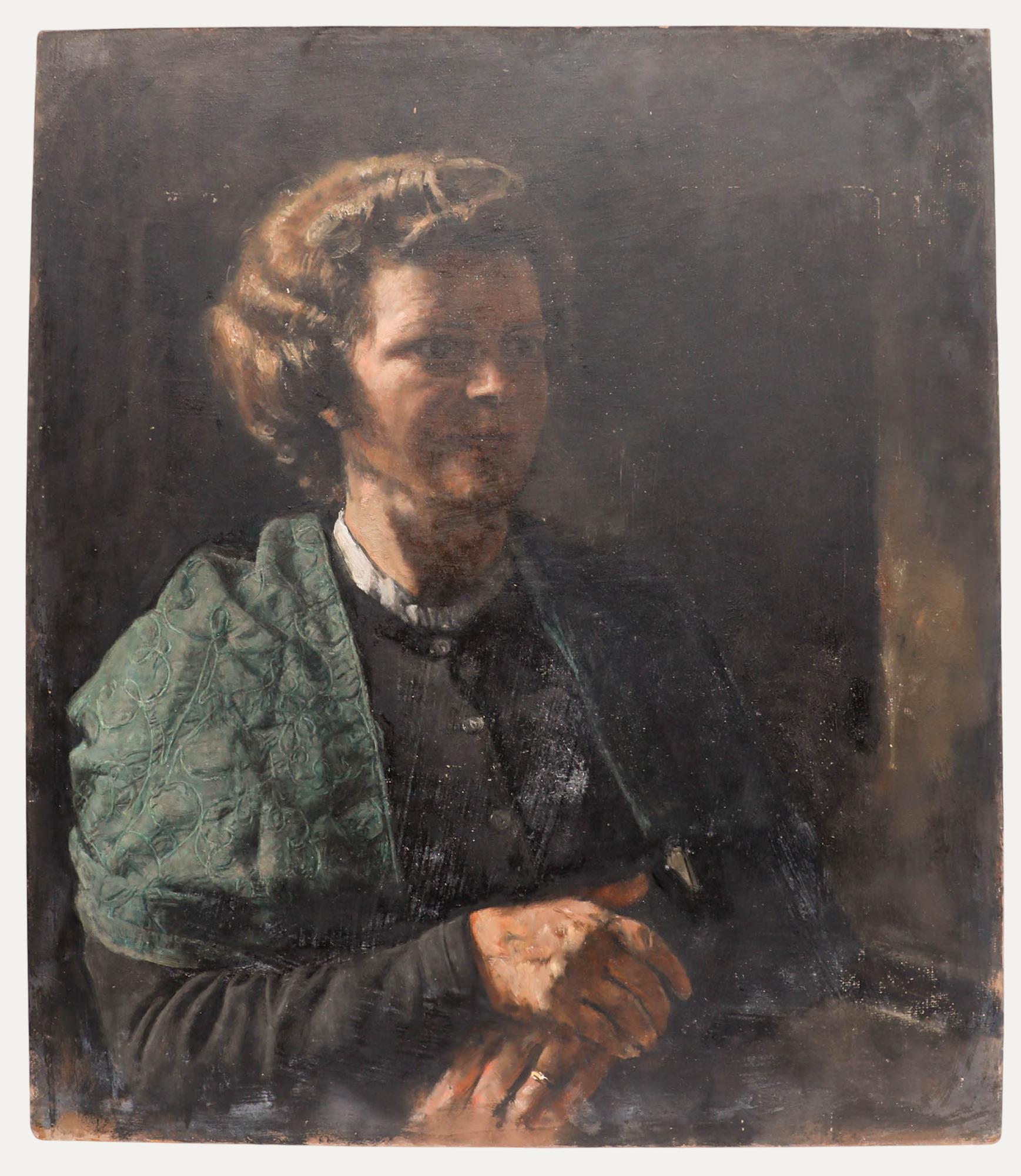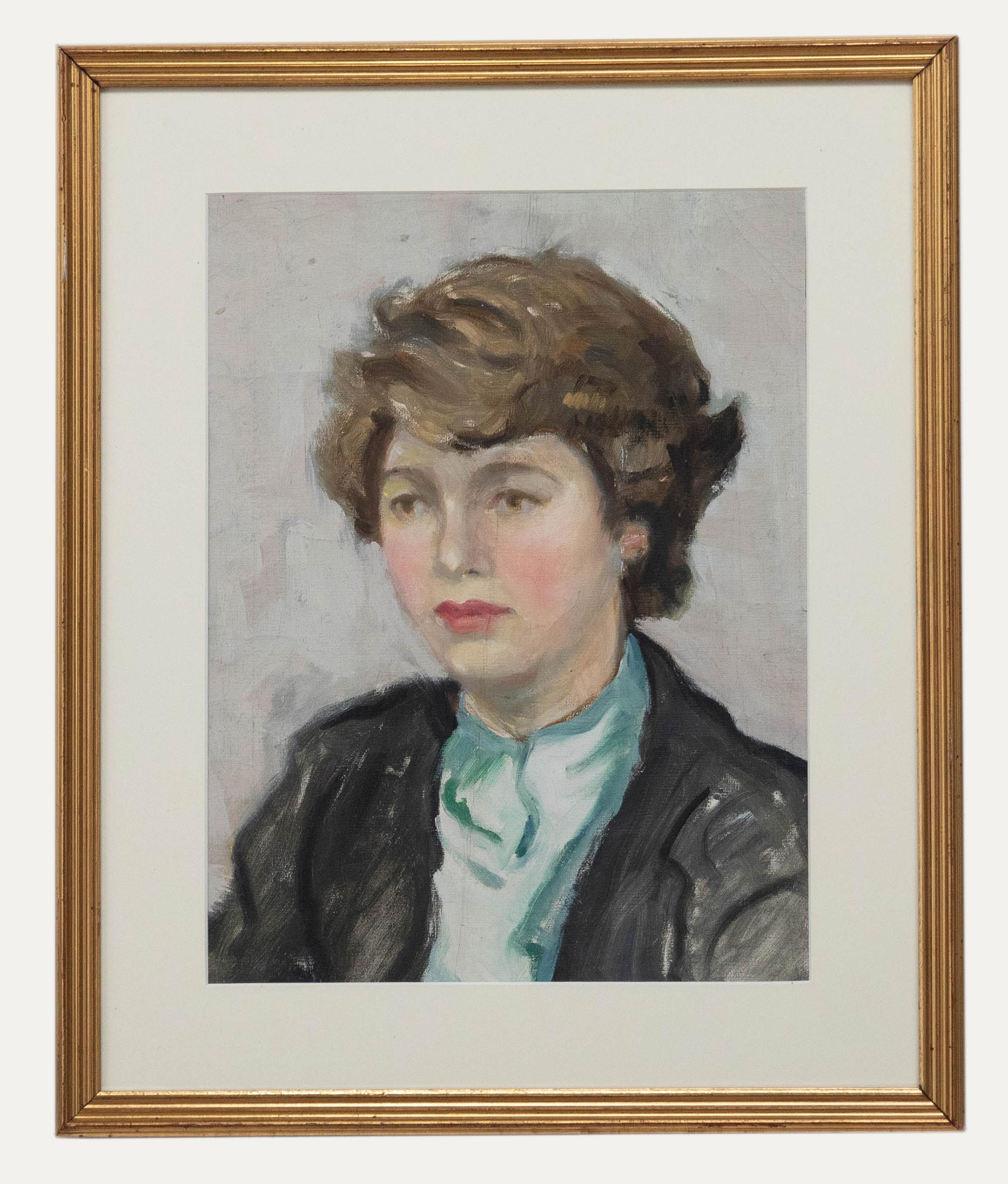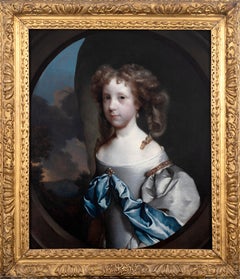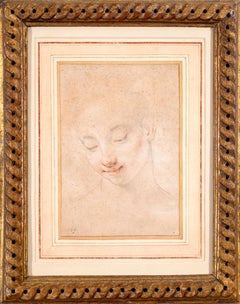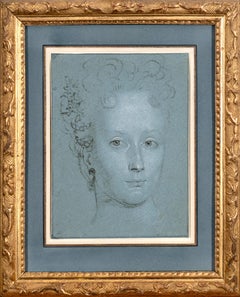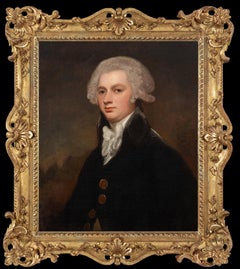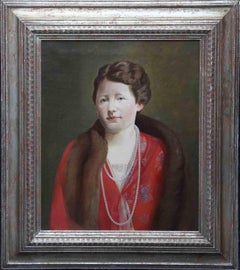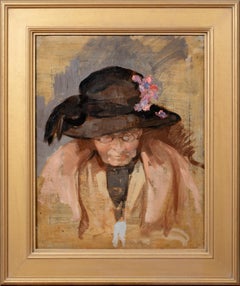Items Similar to Portrait of the artist’s cousin, Gladys Coombs (1899-1963), c. 1920-25
Want more images or videos?
Request additional images or videos from the seller
1 of 10
John George HookhamPortrait of the artist’s cousin, Gladys Coombs (1899-1963), c. 1920-251920s
1920s
$4,562.16
$9,057.2249% Off
£3,400
£6,75049% Off
€3,933.22
€7,808.5949% Off
CA$6,411.43
CA$12,728.5649% Off
A$6,972.57
A$13,842.6049% Off
CHF 3,673.31
CHF 7,292.5949% Off
MX$84,683.19
MX$168,121.0349% Off
NOK 46,180.87
NOK 91,682.6249% Off
SEK 43,290.84
SEK 85,945.0549% Off
DKK 29,529.46
DKK 58,624.6749% Off
About the Item
John George Hookham (1899-1972)
Portrait of the artist’s cousin, Gladys Coombs (1899-1963), c. 1920-25
With a figure study verso
Oil on canvas
In an attractive, stylised ‘Lely’ type frame
81.8 x 57 cm.; (within frame) 95.4 x 70.3 cm.
Unsigned
Provenance:
The sitter, Gladys Coombs, and thence by family descent until 2025;
From whom acquired.
The sitter’s intent visual engagement speaks to her relationship with the artist, her maternal cousin of the same birth year of 1899. Hookham evidently practised his early skill on willing relatives, exhibiting a portrait of his father as his 1922 debut at the Royal Academy. Coomb’s apparent youth dates the work to this first half of the 1920s, as does her fashion, which consists of a tailored jacket over a silk or cotton blouse with a scalloped collar, modestly embellished with a gold and pearl stick pin or bar brooch. Elegantly combining the modes of the post-war ‘modern woman’ with a lingering Edwardian restraint, Coombs’ attire is both feminine and practical. Likewise, the loose arrangement of her hair, pinned up and possibly manually waved, predates the more cropped and elaborate hairstyles of the later 1920s.
Hookham’s style is equally distinct to this progressive period. Whereas Coombs’ face is inevitably more highly worked, the brushwork of her jacket is typically loose, with thinned pigment gesturally shaping the uppermost detail. This confident application echoes the predominate style established by the leading artists, including Sir William Nicholson, Harold Knight, and John Harrington Mann. Yet Hookham introduces an unusual and striking compositional feature with the sitter’s surround, enclosing his relation within a background of a deep wine colour. Broad applications of a more vibrant tone (presumably mixed later than the darker background pigment) are used to precisely shape Coombs’ shoulders by ‘shaving down’ the existing paint.
John Hookham was the son of William B. Hookham (1858-1953) and Mary Hansford (1868-1948). He is recorded as having lived at 24 Donovan Avenue, Muswell Hill, London. Hookham studied at the Slade, where in 1923 he came joint first in the Slade School of Art prize in figure painting. Hookham exhibited at the Royal Academy first in 1922, and later in 1934 and 1938, where his submission was hung in Gallery IV alongside works by Sir John Lavery, Harold Knight, and Stanhope Forbes. Hookham was later associated with Cambridge, teaching at Cambridge School of Art. Bernard Dolman notes that Hookham exhibited at Rossiter’s Gallery (Cambridge), a dealership operated at 8 Rose Crescent by James Rossiter. Mary Hansford (Hookham’s mother) was the daughter of Alice Anne Reynolds and Anthony Hansford, whose brother Frederick Hansford and his wife Emily Cave had Gladys Hansford and Priscilla Hansford. Gladys married Charles Coombs in 1930.
Bibliography and further reading:
Bernard Dolman, Who’s Who in Art, 2 vols. (London: The Art Trade Press Ltd., 1929)
- Creator:John George Hookham (1899 - 1972, British)
- Creation Year:1920s
- Dimensions:Height: 37.56 in (95.4 cm)Width: 27.68 in (70.3 cm)
- Medium:
- Movement & Style:
- Period:
- Condition:
- Gallery Location:Henley-on-Thames, GB
- Reference Number:1stDibs: LU2820216465712
About the Seller
No Reviews Yet
Vetted Professional Seller
Every seller passes strict standards for authenticity and reliability
Established in 2024
1stDibs seller since 2024
- ShippingRetrieving quote...Shipping from: Henley-on-Thames, United Kingdom
- Return Policy
Authenticity Guarantee
In the unlikely event there’s an issue with an item’s authenticity, contact us within 1 year for a full refund. DetailsMoney-Back Guarantee
If your item is not as described, is damaged in transit, or does not arrive, contact us within 7 days for a full refund. Details24-Hour Cancellation
You have a 24-hour grace period in which to reconsider your purchase, with no questions asked.Vetted Professional Sellers
Our world-class sellers must adhere to strict standards for service and quality, maintaining the integrity of our listings.Price-Match Guarantee
If you find that a seller listed the same item for a lower price elsewhere, we’ll match it.Trusted Global Delivery
Our best-in-class carrier network provides specialized shipping options worldwide, including custom delivery.More From This Seller
View AllPortrait of a girl, possibly Dorothy Bigg (née Wither) (1661-1717), c. 1674
By Gerard Soest
Located in Henley-on-Thames, England
Gerard Soest (c. 1600-1681)
Portrait of a girl, possibly Dorothy Bigg (née Wither) (1661-1717), c. 1674
Half-length, wearing natural pearl and gemstone jewellery
Oil on canvas
In...
Category
1670s Old Masters Portrait Paintings
Materials
Oil
Study of a female head, gazing downwards
Located in Henley-on-Thames, England
Giovanni Battista Vanni (1599-1660), c. 1629
Study of a female head, gazing downwards
Black chalk and sanguine on laid paper, within partial red ink framing lines (inscribed No. 13 v...
Category
1620s Baroque Portrait Drawings and Watercolors
Materials
Chalk
Portrait study of a Lady, wearing precious stones and pearls
Located in Henley-on-Thames, England
Adriaen van der Werff (1659-1722) (attrib.)
Portrait study of a Lady, wearing precious stones and pearls
Black and white chalk, heightened with white, on blue paper
Inscribed verso, ...
Category
17th Century Rococo Portrait Drawings and Watercolors
Materials
Chalk
Portrait of a Gentleman, traditionally identified as Edward Addison, Esq., 1780s
By George Romney
Located in Henley-on-Thames, England
George Romney (1734-1802)
Portrait of a Gentleman, traditionally identified as Edward Addison, Esq., c.1780s
Oil on canvas
In a period carved and gilded swept frame
76.3 x 63.2 cm.; ...
Category
1780s Old Masters Portrait Paintings
Materials
Oil
Portrait of George Gordon, 7th Laird of Buckie (1707-1756)
By John Alexander
Located in Henley-on-Thames, England
John Alexander (Scottish, 1686-1766)
Portrait of George Gordon, 7th Laird of Buckie (Scottish, 1707-1756), c. 1743
Oil on canvas
In a carved ebonised frame, with gilded inner slight...
Category
1740s Old Masters Portrait Paintings
Materials
Oil
Watercolour study of a resting infant, possibly the artist's daughter
By William Henry Hunt
Located in Henley-on-Thames, England
William Henry Hunt OWS (1790-1864) (attrib.)
Study of a resting infant
Watercolour and graphite heightened with zinc oxide on paper
13.9 x 18.5 cm.; (within frame) 31.1 x 25.6 cm.
Un...
Category
Mid-19th Century Victorian Portrait Drawings and Watercolors
Materials
Watercolor
You May Also Like
Portrait of Elizabeth Exley - British Art Deco 1930's portrait oil painting
By James Robert Granville Exley
Located in Hagley, England
This lovely British Art Deco portrait oil painting is by noted artist James Robert Granville Exley and provenance is by family descent. The sitter is Elizabeth Exley, possibly his wi...
Category
1930s Art Deco Portrait Paintings
Materials
Oil
Portrait of Louisa Ann Inglis 1857-1935 - British Victorian art oil painting
By William George Robb
Located in Hagley, England
This lovely British Edwardian Impressionist portrait oil painting is by noted artist William George Robb. Painted circa 1901 the sitter is Louisa Ann Inglis, wife of Sir Charles Ingl...
Category
Early 1900s Victorian Portrait Paintings
Materials
Oil
$8,855 Sale Price
20% Off
Portrait Of The Artists Mother, early 20th Century by VIOLET EVELYN ARNOTT
Located in Blackwater, GB
Portrait Of The Artists Mother, early 20th Century
by VIOLET EVELYN ARNOTT (1901-1953) - exhibited work
Large early 20h century portrait of the artists mother, oil on canvas by Vi...
Category
Early 20th Century Portrait Paintings
Materials
Canvas, Oil
$2,566 Sale Price
25% Off
Portrait of a 1920's Lady - American Art Deco female portrait oil painting
Located in Hagley, England
American artist Henry R Rittenberg painted this lovely 1920's Art Deco portrait oil painting. The painting is a standing half length portrait of a lady in a black coat with a white fur collar over a red dress and long beads. She has an elegant 1920's short bob hair style and a confident expression. The strong brushwork and range of tones within one colour are superb. A really striking Art Deco portrait oil painting.
Signed upper left.
Provenance. Dorset estate.
Condition. Oil on canvas, 30 inches by 25 inches and in good condition.
Frame. Housed in a fine James Bourlet panel silvered frame, 40 inches by 35 inches and in good condition.
Henry R Rittenberg (1879-1969) was born in Libau, Latvia and later immigrated to the United States. He studied art at the Bavarian Academy in Germany, and by 1906, was in Philadelphia, where he attended the Pennsylvania Academy of Fine Art. Rittenberg painted landscapes and still lifes, yet his forte was portraiture. The artist was commissioned to paint a number of portraits of American dignitaries including Attorney General Homer Stille Cummings and a group portrait of President Harry S...
Category
1920s Art Deco Portrait Paintings
Materials
Oil
George Weissbort (1928-2013) - 20th Century Oil, An Elegant Lady
By George Weissbort
Located in Corsham, GB
A delightful oil study by the artist George Weissbort (1928-2013). Unsigned. (Provenance: Studio Sale, George Weissbort). On board.
Category
20th Century Portrait Paintings
Materials
Oil
Attrib. Philip Naviasky (1894-1983) - Framed Mid 20th Century Oil, Portrait
By Philip Naviasky
Located in Corsham, GB
Portrait of a Lady wearing a turquoise blouse and black blazer with touch of rogue on her lips and cheeks. Well-presented in a smart gilt frame. Unsigned. (Provenance: private collec...
Category
20th Century Portrait Paintings
Materials
Oil
$479 Sale Price
20% Off
More Ways To Browse
Stick Pearl
Mother Mary
Antique Hair Pin
Pearl Stick Pins
Alice Reynolds
John Riley
John Voss
Oil Painting Old Fisherman
Oval Rococo Portrait
Portrait Habsburg
Princess Diana Painting
Procaccini Giulio Cesare
Robert Montgomery
Rosie Huntington Whiteley
Tarkay Oil Paintings
Tarkay Oil
Vintage Formula One Cars
Walter Stuempfig
